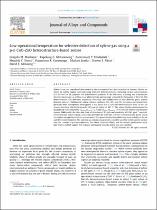| dc.contributor.author | Cummings, Franscious R | |
| dc.contributor.author | Maebana, Lekgolo M | |
| dc.contributor.author | Rapelang G., Motsoeneng | |
| dc.contributor.author | Zamaswazi P, Tshabalala | |
| dc.date.accessioned | 2024-01-24T14:02:36Z | |
| dc.date.available | 2024-01-24T14:02:36Z | |
| dc.date.issued | 2023 | |
| dc.identifier.citation | Maebana, L.M., Motsoeneng, R.G., Tshabalala, Z.P., Swart, H.C., Cummings, F.R., Jozela, M., Nkosi, S.S. and Motaung, D.E., 2023. Low-operational temperature for selective detection of xylene gas using a pn CuO-ZnO heterostructure-based sensor. Journal of Alloys and Compounds, 960, p.170683. | en_US |
| dc.identifier.uri | http://dx.doi.org/10.1016/j.jallcom.2023.170683 | |
| dc.identifier.uri | http://hdl.handle.net/10566/9259 | |
| dc.description.abstract | Xylene is not just considered detrimental to the environment but also hazardous to humans. Herein we report on xylene vapour detection using CuO-ZnO heterostructures containing various concentrations (0.1–2.0 wt%) of Zn, prepared via hydrothermal synthesis. X-ray diffraction, scanning, and transmission electron microscopy, as well as x-ray photoelectron spectroscopy, validated the formation of the CuO-ZnO heterostructure. Gas detection, sensitivity, selectivity, and stability tests of nine different gases, namely benzene, toluene, ethylbenzene, xylene, ethanol, methane, SO2, NO2, and CO2 at various operational temperatures were subsequently investigated. It was found that a CuO-ZnO heterostructure with 1.0 wt% Zn showed excellent selectivity towards 100 ppm of xylene at 100 °C. | en_US |
| dc.language.iso | en | en_US |
| dc.publisher | Elsevier Ltd | en_US |
| dc.subject | CuO | en_US |
| dc.subject | Gas sensor | en_US |
| dc.subject | Heterostructure | en_US |
| dc.subject | Xylene | en_US |
| dc.subject | ZnO | en_US |
| dc.title | Low-operational temperature for selective detection of xylene gas using a p-n CuO-ZnO heterostructure-based sensor | en_US |
| dc.type | Article | en_US |

